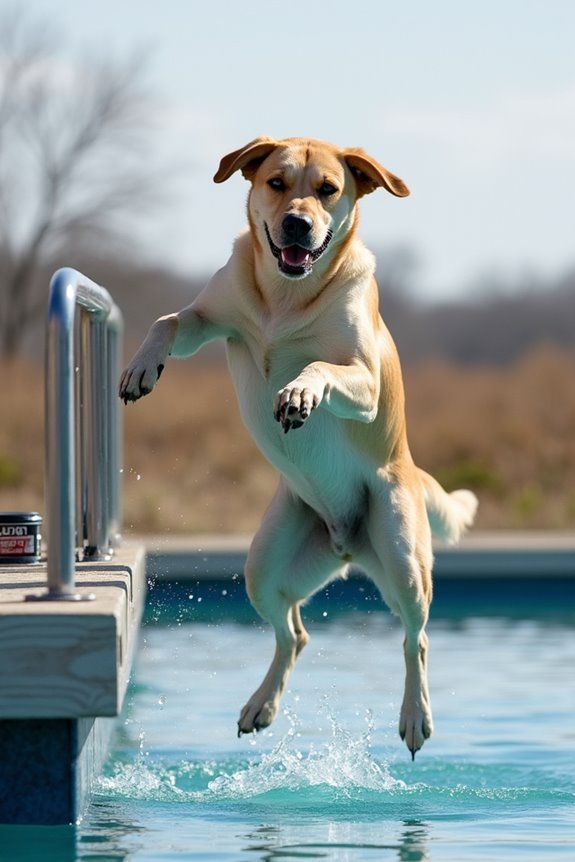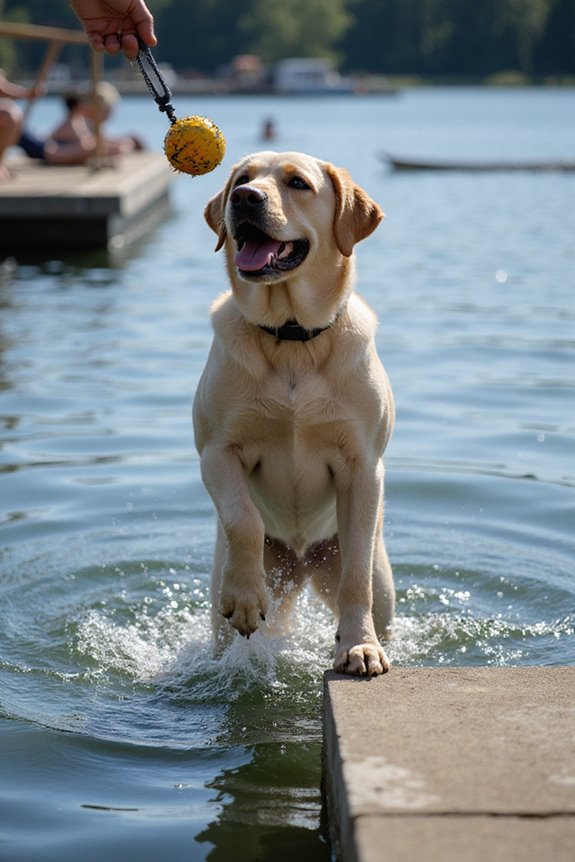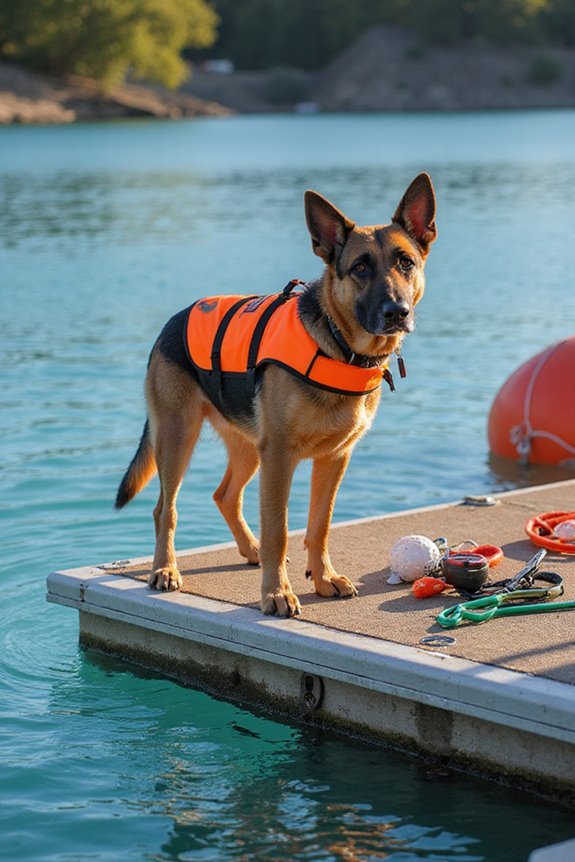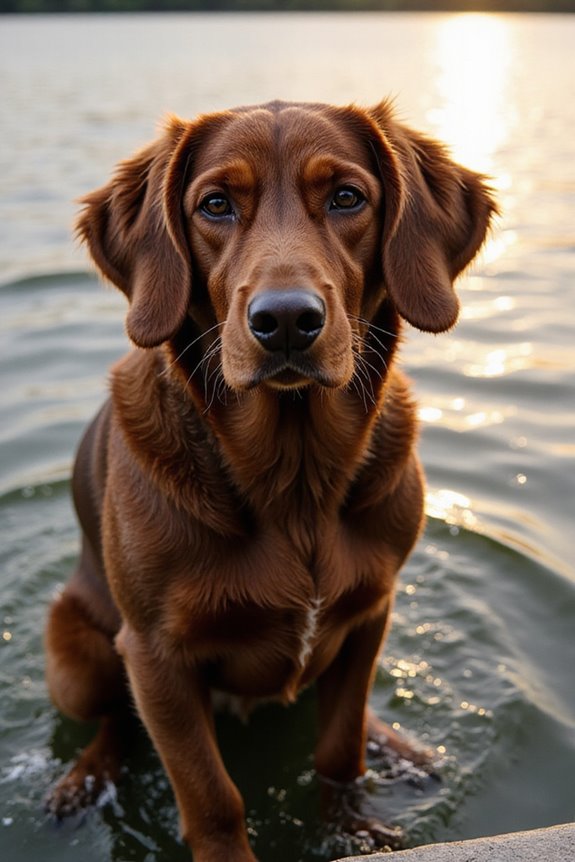To train for dock diving, I recommend starting with a thorough assessment of your dog’s swimming skills, including their willingness to swim and ability to exit the pool. Gradually introduce them to water, employing positive reinforcement. Next, focus on jump training techniques, increasing distance using toys, and practice commands. Ascertain safety with appropriate gear, maintain a clean dock, and monitor fatigue. Setup should simulate competitive conditions, and stay tuned for advanced training strategies to enhance performance further.
Key Takeaways
- Start with gradual water introduction to build comfort, using shallow areas and positive reinforcement techniques.
- Teach jump techniques by using favorite floating toys and consistent commands for effective launches.
- Incorporate run-and-jump drills on the dock to simulate competition conditions and build explosive power.
- Practice distance jumping exercises to improve confidence and endurance, setting progressive mini goals for tracking progress.
- Maintain safety by using well-fitted life vests, monitoring for fatigue, and ensuring a non-slip surface during training.
Assess Your Dog’s Swimming Skills
When evaluating your dog’s swimming skills, how can you guarantee they’re ready for the challenges of dock diving? First, assess their swimming proficiency. Your dog should be willing to swim in water over their head without coaxing, demonstrating water confidence.
Key points to contemplate include:
- Exit Skills: Verify they can independently exit the pool using a ramp.
- Enthusiasm: Observe their keenness to chase toys and enter water environments; these traits indicate a readiness for dock diving.
- Comfort: Look for signs of relaxation in unfamiliar settings, especially near a dock.
- Swimming Technique: Monitor their ability to swim steadily without distress and their effectiveness at retrieving objects.
If they meet these criteria, you’re on the right path for successful training.
Gradual Water Introduction

Introducing your dog to water requires careful consideration and a structured approach to guarantee both safety and comfort. Start by allowing your dog to explore shallow water areas, ensuring they build initial water comfort without pressure. Use positive reinforcement, like treats and praise, to create enjoyable associations with water.
Gradually increase the water depth over multiple sessions, monitoring their confidence closely. Maintain short, frequent sessions to prevent overwhelm. Always conduct introductions in calm environments, devoid of distractions. Employ favorite toys and play-based activities to encourage engagement.
Jump Training Techniques

Jump training techniques are essential for developing your dog’s dock diving skills effectively. Start by gradually increasing jump distance, using a favorite floating toy to build confidence near the dock’s edge. Once your dog is comfortable, incrementally throw the toy further to encourage longer leaps, focusing on maximizing airtime for improved horizontal jump length.
Master launch techniques with solid push-offs from the dock, using consistent behavioral commands like “Get it!” to signal jumps. Incorporate explosiveness training through strength exercises such as sprinting and hurdle jumps. Finally, consistently practice both the Place and Send and Chase methods, adapting as your dog’s skills improve. This structured approach will enhance your dog’s performance and overall confidence in dock diving.
Building Excitement and Repetition

Building excitement and repetition in dock diving training can greatly enhance a dog’s performance and engagement in the activity. To spark interest, I introduce the dock gradually, throwing a favorite floating toy to create an excitement trigger that associates fun with diving. Consistently using motivation techniques like the “fetch” command helps establish jumping as an enjoyable game.
Repetitive drills are crucial; I maintain consistent hand signals and commands during practice to foster predictability. It’s important to balance challenges, gradually increasing jump distances while allowing for adequate rest to keep the dog engaged. By reinforcing successful dives with praise or treats, I create a positive loop that builds confidence, solidifying the connection between dock diving and rewarding experiences.
Ensuring Safety During Training

Guaranteeing the safety of your dog during dock diving training is paramount, as it protects their well-being and enhances the overall training experience. By implementing key safety precautions, you can help with injury prevention and create a positive environment for your dog.
- Use flat collars or well-fitted life vests during training.
- Limit active jumps to short intervals, allowing rest periods between attempts.
- Keep the dock free from debris and guarantee a non-slip surface for secure footing.
- Monitor for signs of fatigue or distress, stopping abruptly if necessary.
- Provide adequate hydration and maintain a comfortable ambient temperature.
These steps can lead to safer training sessions, fostering trust, and enjoyment in both you and your dog as you explore the exciting world of dock diving.
Setting Up the Right Environment
Setting up the right environment for dock diving involves careful consideration of several factors that can influence your dog’s performance and safety. Here are key aspects to focus on:
- Dock Dimensions: A minimum of 40 feet in length and 7.5 feet in width guarantees ample running space. The dock should also be elevated 2 feet above water to meet competition standards.
- Water Cleanliness: It’s essential that the water is clean and clear. Debris and algae can pose health risks and hinder visibility.
- Safety Features: Provide ramps or steps for easy exit after jumps, along with proper barriers on the dock edges.
- Controlled Environment: Prefer pools over natural ponds to minimize unpredictability in swimming conditions.
Essential Equipment for Success
Creating the right environment for dock diving lays the foundation for success, but having access to the appropriate equipment is equally important for guaranteeing a smooth and effective training experience.
Essential Equipment Considerations
- Dock Materials: Choose a non-slip, sturdy platform with the correct size and height to meet safety regulations. Confirm water access is calm and clear, free from currents.
- Toy Selection: High-reward, water-safe toys are essential. Opt for floating bumpers or foam dummies that dogs can easily carry without choking hazards. Your dog may need different options to find their favorite motivator.
- Safety Gear: A fitted life jacket is critical for inexperienced swimmers. Regularly check water quality, and keep first aid supplies and drying towels handy to guarantee your dog’s well-being during training sessions.
Preparing for Competition
Preparing for dock diving competition involves meticulous planning and thorough training to secure your dog performs at their best. Establishing a competition mindset is vital; I focus on fostering both physical and mental readiness through structured training sessions.
- Engage in run-and-jump drills to build explosive power.
- Schedule practice sessions on an actual dock to simulate conditions.
- Implement distance jumping exercises to boost confidence and endurance.
Goal tracking is essential; I set progressive mini goals, such as increasing jump distances, and I continually monitor performance improvements. Encouraging my dog through positive reinforcement keeps motivation high. Finally, maintaining my dog’s health and hydration secures peak performance during competition, safeguarding against potential stressors that could hinder our success on the dock.
Advanced Training Strategies
When it comes to advancing your dog’s dock diving skills, implementing targeted training strategies is crucial for enhancing overall performance.
Vertical Jumping Techniques:
- Use progressively higher toy holds to encourage powerful vertical leaps.
- Guarantee safe water entry post-jump to reduce injury risk.
- Strengthen shoulder and hind leg muscles to improve jump height.
- Conduct controlled repetitions allowing for recovery to prevent fatigue.
- Track improvements using video analysis for precise performance metrics.
Speed Retrieve Drills:
- Conduct timed retrieval for quick reactions; use motivating toys to encourage drive.
- Gradually increase toy placement distance to challenge speed and precision.
Frequently Asked Questions
What Breeds Are Best Suited for Dock Diving?
When considering top breeds for dock diving, I’ve found that Labrador Retrievers, Golden Retrievers, and Belgian Malinois excel. With the right training techniques, your dog’s natural skills can truly shine and make diving a joy!
How Often Should Training Sessions Be Conducted?
I’ve found that training frequency is key for success. I typically schedule sessions three times a week, each lasting about 15 to 20 minutes. This keeps my dog fit and ready for any challenge ahead.
Can Older Dogs Participate in Dock Diving?
Absolutely, older dogs can enjoy dock diving! Just remember senior dog considerations like joint health and dock diving safety. With the right approach, it’s a fun way to keep our beloved companions active and engaged.
What Should I Do if My Dog Is Afraid of Water?
Picture a gentle river, flowing slowly. I’ve found water acclimation techniques work wonders, and by using positive reinforcement methods, I guarantee my pup feels safe and loved while embracing their watery adventure. Let’s plunge in together!
Are There Any Dietary Recommendations for Dock Diving Dogs?
I’ve found that nutritional supplements, like glucosamine and DHA, are essential for my dock diving dog. I also keep a consistent feeding schedule, which helps maintain her energy and focus during training sessions.




